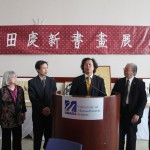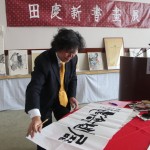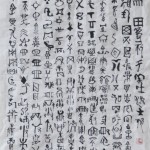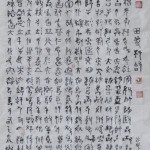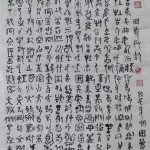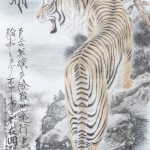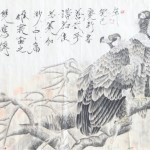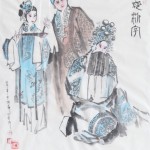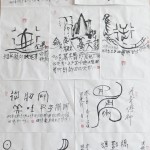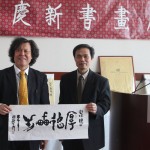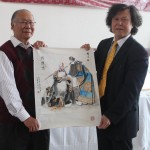By David Li, bostonese.com
Boston, April 7, 2013, — Tian Qingxin, a well-known Chinese traditional calligraphy artist and painter, held an art exhibition at UMass Boston today. This exhibition was sponsored by University of Massachusetts Confucius Institute. About 40 amazing art works were on display and drew rave reviews from the audience.
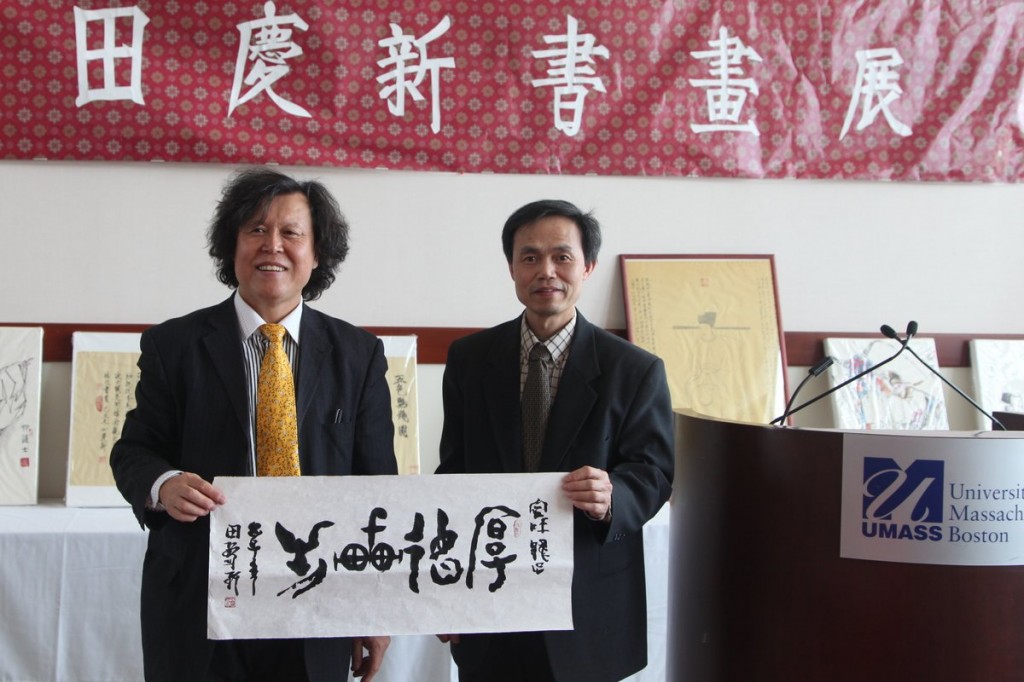
Mr. Tian Qingxin (left) wrote a famous four-word quotation 厚德載物 from Yi Jing in oracle script calligraphy for Eadwn Huang, president of NAAA.
|
|
Some well-known local Chinese artists Jing-Ming Huang, Eadwn Huang, Wen-Xi Zhou from North America Artist Association (NAAA) were on hand along with many attendees of the Chinese Bridge US High School Student Chinese Speech Contest. Jing-Ming Huang praised the years of hard work by Tian Qingxin in deciphering the ancient Chinese Oracle Script characters and brought them alive in these beautiful calligraphy works.
“This is my first exhibition in the US, and hopeful there will be more to come,” said Mr. Tian. He also expressed his sincere thanks to Chengyun Liu and Baifeng Sun of University of Massachusetts Confucius Institute for their support for this exhibition. |
Bio of Tian Qingxin
Tian Qingxin, also known as Guomeng, styles himself Yi-Tian (one day in Chinese) Daniel. His study was called pure fresh attic. He was born in Dalian city of Liaoning Province in April, 1959. He finished his undergraduate studies from the Chinese Language department of Liaoning University and obtained his master degree in the economic administration department of Northeastern University of Finance and Economics. He is not only a senior economist but also a professional calligrapher. He works as vice-secretary-general of Fushun Calligrapher Association. He is Chinese painting and Calligraphy Association member, member of Chinese society of couplets, member of the Chinese Collector Association, member of Chinese Arts of public relations committee. He serves as the vice president of International Academy of painting and calligraphy, the director of North American Artists Association at Liaising Department in Beijing, director of North American Artists Association, the fellow of the American Academy of Asian art.
|
|
Mr. Tian Qingxin has ardently loved calligraphy since his childhood. He has been in the education and financial administration for twenty-eight years and kept practicing calligraphy for forty years. He studied from several great Chinese masters and is a student of Yanyi Shen, Boguang Yu. He is good at “Erwang” styles and is a specialist in Emperor Zhaoji’s “Shoujing” style for twenty years. His works is elegant, delicate and pretty, combining hardness with softness in calligraphy. He becomes an expert in calligraphy all by himself. He held his individual calligraphic exhibitions in Beijing, Shanghai and Nanjing, well known in calligraphic networks. |
He published a calligraphic series of gold edition including The Book of Changes, The Classic of the Virtue of the Tao, The Analects of Confucius and The Art of War. The one-kilometer-long works of his regular script in small characters were collected and stored up by many foreign friends in Euro-America. His book has been collected by the National Library of China, China Association of collectors, National Museum of China, the Buddhist Association of China and other national institutions for the permanent collection. His calligraphy works are published in the textbooks of primary and secondary school. He is one of the most powerful contemporary young artists. He is the first to use Ancient Chinese Oracle Bone Characteristics to write several famous books. His fifth change of “new style of calligraphy”, is to create a system of symbols used in Oracle Bone Characteristics to Internet interface so as to replace the old text refinement and digitally modernize more scientific and reasonable practice in using Chinese characters — the creation of Jiaguwen font.
His outstanding contribution is in explaining the Ancient Chinese characters, creating the first Chinese oracle electronic calligraphy font. At the same time, the body of electronic calligraphy font agglomerate system. Instead of traditional mode of writing on paper, he puts forward the Chinese oracle bone characteristics calligraphy in the computer and multimedia theory. This calligraphy teaching mode plays a significant role in promoting Chinese characteristics and content to form transformation process of higher quality and faster speed. In the future development of Chinese history of Chinese characters, he advocated the oracle bone inscriptions as word based source. In such fifth unifying Chinese characters change, he set up an example by personally taking part in demonstrating globalization Chinese characters and contributing to the development of human language.
